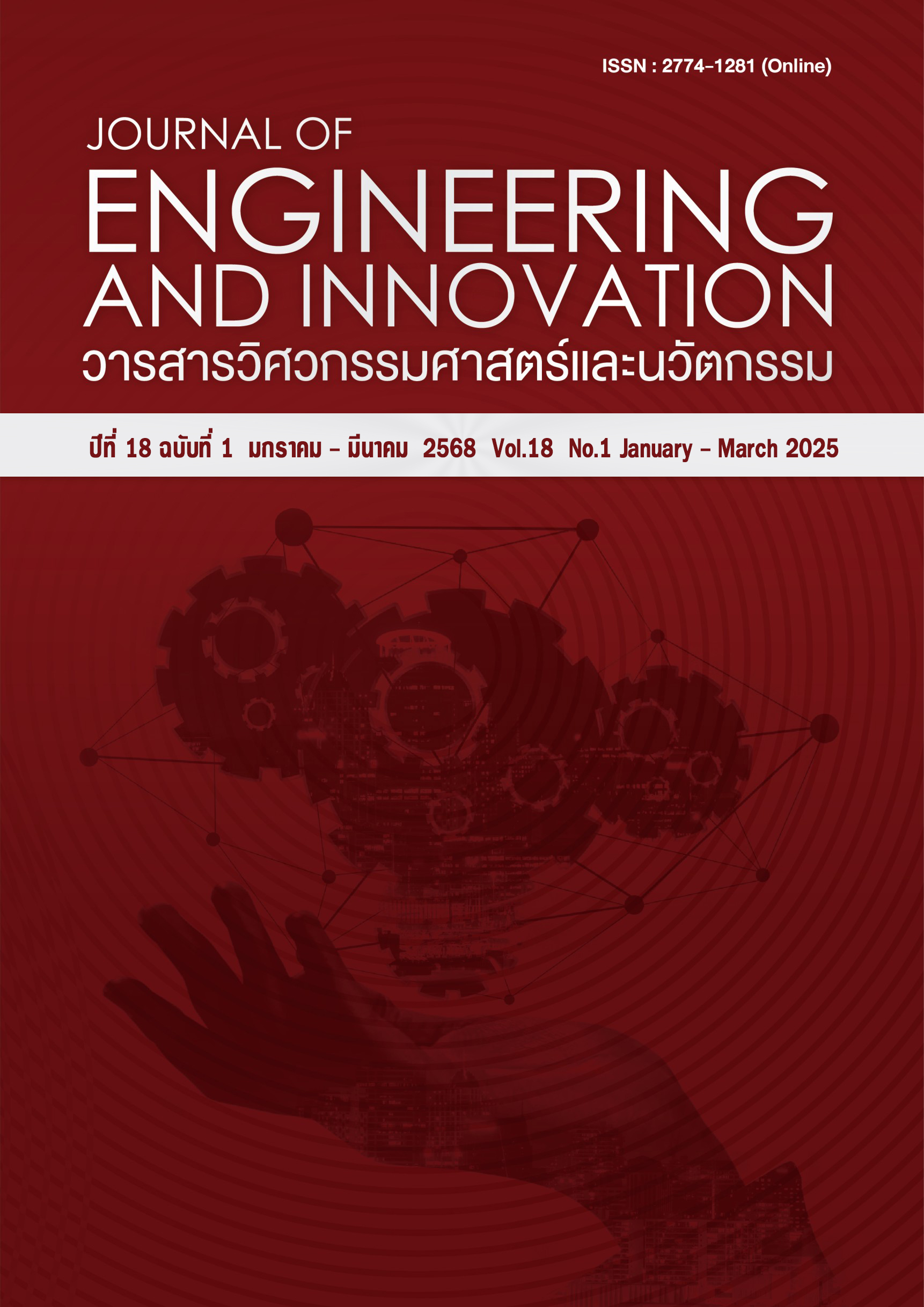แนวทางการเลือกใช้ชนิดของกระจกบานใหญ่ เพื่อการอนุรักษ์พลังงานหรือลดผลกระทบของพลังงานแสงอาทิตย์ในอาคารสูง กรณีศึกษาอาคารสำนักงานความสูงตั้งแต่ 25 ชั้นขึ้นไป ในเขตกรุงเทพมหานคร
Main Article Content
บทคัดย่อ
งานวิจัยฉบับนี้นำเสนอการศึกษาผลกระทบของพลังงานแสงอาทิตย์ต่อกระจกบานใหญ่ (Curtain wall) ชนิดต่างๆ ในอาคารสูงประเภทอาคารสำนักงาน โดยพิจารณาข้อมูลจากการสัมภาษณ์ผู้ออกแบบ จาก 4 บริษัทชั้นนำที่เคยออกแบบอาคารสำนักงานสูงเกินกว่า 25 ชั้น จำนวน 4 โครงการ ในเขตพื้นที่กรุงเทพมหานคร โดยการศึกษามุ่งชี้ให้เห็นผลกระทบจากการใช้กระจกหลายประเภททั้งที่อยู่ในเกณฑ์และต่ำกว่าเกณฑ์ที่กฎหมายกำหนดในด้านการอนุรักษ์พลังงาน ตามเกณฑ์มาตรฐานประสิทธิภาพพลังงานขั้นต่ำ โดยใช้เกณฑ์ Building Energy Code (BEC) ผู้วิจัยได้ใช้วิธีทดสอบโดยการจำลองค่าอาคารต้นแบบอนุรักษ์พลังงาน และนำค่าคุณสมบัติกระจกในประเภทเป็นทางเลือกทดสอบให้เห็นค่าประสิทธิภาพและความคุ้มค่าเมื่อเปรียบเทียบระหว่างค่าประสิทธิภาพและราคา เพื่อให้เจ้าของอาคารหรือผู้ออกแบบทั้งสถาปนิกและวิศวกร สามารถพิจารณากระจกที่เหมาะสมในการต้านทานความร้อนจากรังสีอาทิตย์ โดยสามารถเลือกกระจกที่ประสิทธิภาพดี ในราคาที่เหมาะสมตามโครงสร้างต้นทุนค่าก่อสร้างที่เจ้าของโครงการได้วางแผนไว้แล้ว ผลจากการวิจัยได้หลักเกณฑ์เพื่อกำหนดรูปแบบกระจก โดยการทดลองคำนวณเปรียบเทียบค่า OTTV ในโปรแกรม BEC web-base โดยอ้างอิงค่าจากการคำนวณและแสดงผลด้วยกราฟ เพื่อแสดงการเปรียบเทียบทั้งค่าการอนุรักษ์พลังงานและต้นทุนค่าผนังกระจกบานใหญ่ ผลการศึกษาจากกระจกที่ทำการทดสอบหาค่าพบว่า ค่า OTTV ในกลุ่มที่ 2 ชนิดกระจกอินซูเลต ความหนากระจกแผ่นหน้า 6 มม.+ ช่องว่างอากาศระยะ 12 มม.+ความหนากระจกแผ่นหลังหนา 6 มม. มีค่าการประหยัดพลังงานดีปานกลาง และมีราคาไม่สูง และมีคุณสมบัติเป็นไปตามข้อกำหนดเรื่องการประหยัดพลังงาน ทว่าการนำข้อมูลสรุปไปใช้ สถาปนิกหรือวิศวกรผู้ออกแบบ นอกจากพิจารณาค่าการประหยัดพลังงานและราคาแล้ว ควรจะต้องคำนึงถึงระเบียบและกฎหมายปัจจุบัน ที่มีการเพิ่มข้อกำหนดให้กระจกแผ่นนอกสุดจะต้องไม่หลุดร่วงลงมาเป็นอันตรายต่อผู้สัญจรภายนอกด้านล่างได้ ดังนั้นสถาปนิกจำเป็นต้องพิจารณากระจกตามค่าประสิทธิภาพจากกลุ่มที่ 3 (เป็นกลุ่มที่มีการติดฟิล์มกันร่วงที่แผ่นนอก) และเลือกชนิดที่ราคาเหมาะสมตามงบประมาณจากกลุ่มดังกล่าว เพื่อนำมาใช้ในการสรุปออกแบบให้ผ่านเกณฑ์อนุรักษ์พลังงานตามที่กฎหมายกำหนด และอยู่ในกรอบงบประมาณของโครงการ
Article Details
เอกสารอ้างอิง
กรมพัฒนาพลังงานทดแทนและอนุรักษ์พลังงาน กระทรวงพลังงาน; Bec web-based. Ministry of energy. Available from: https://bec.energy.in.th/ dashboard# [Accessed 16th October 2020].
Button D, Pye B. Glass in Building. Jordan Hill. Oxford: Butterworth-Heinemann; 1993.
Fanger PO. Calculation of thermal comfort, Introduction of a basic comfort equation. ASHRA. Transactions.; 1967.
German International Cooperation. แนวทางเบื้องต้นในการออกแบบอาคารอนุรักษ์พลังงานประสิทธิภาพสูงเชิงสถาปัตยกรรม; 2016. Available from: https://www.thai-german-cooperation. info/th/giz-eppo- launched-an-architectural-guidebook-for-high-energy-efficient-building-design/ [Accessed 15th November 2020].
Givoni B. Passive and Low Energy Cooling of Buildings. New York: Van Nostrand Reinhold.; 1994.
Gupta MY. Carbon credit. A step towards green environment. Global Journal of Management and Business Research. 2011. p11(5).
Taleb H, Ahmad H. Simulation Study of Active Shading System. Available from: https:// www.academia.edu/38900516/Simulation_Study_of_Active_Shading_System_In_Residential_Building_In_UAE. [Accessed 15th October 2021].
Sacht HM, Bragança L, Almeida MG. Facades Modules for Eco-Efficient Refurbishment of Buildings. Available from: www.irbnet.de/daten/ iconda/ CIB17378.pdf [Accessed 11th September 2021].
Wurm J. Glass Structures Design and Construction of Self-Supporting Skins, Available from: https://books.google.co.th/books?id= DLmaaA1Jq8C&printsec=frontcover&hl=th&source=gbs_ge_summary_r&cad=0#v=onepage&q&f=false [Accessed 7th October 2021].
Liu Y, Yu F, Su S, Lam H. A Cost-Benefit Evaluation Server for decision support in e-business. Available from: http://www.efsa. unsa. ba/-nijazbajgoric/ dst/dss2.pdf [Accessed 12th June 2021].
Lyson P. & Hockings B. Technical manual home. Retrieved June 5, 2009. Available from: http://www.yourhome.gov.au/technical/pubs/fs410.pdf [Accessed 8th March 2021].
Moore F. Environmental Control Systems: Heating Cooling Lighting. New York: Mc Grawl-Hill; 2008.
O’Leary C. Thermal Comfort. Berkeley: University of California, Berkeley. Available from: http://www.aee-intec.at/0uploads /dateien 326.pdf. [Accessed 22th June 2021].
Onestockhome co.,ltd. Available from: https://www. onestockhome.com/th [Accessed 15th October 2020]
Pongyen N, Waroonkun T. Design guidelines for improving outpatient building of a community hospital in order to increase satisfaction. Journal of Environmental Design. 2014;1(2):49-80.
Ridthplake S, Boonkham W. Greenhouse gasses (carbon dioxide gas) assessment from municipal solid waste management system in ban-yang, buriram province. Journal of Energy and Environment Technology of Graduate School Siam Technology College. 2020;7(1):29-37.
Sharma A, Saxena A, Sethi M, Shree V. Life cycle assessment of buildings: a review. Renewable and Sustainable Energy Reviews. 2011;15(1):871-875.
Surachotivet T. Anlysis life cycle energy of building construction: a case study multi-purpose building of silpakorn university, graduate school. Bangkok, Thailand: Silpakorn University; 2018.
Tuhus -Dubrow D, Krarti M. Genetic-algorithm based approach to optimize building envelope design for residential buildings. Building and environment. 2010;45(7):15,74-81.
การไฟฟ้าฝ่ายผลิตแห่งประเทศไทย. ค่าไฟฟ้า FT. 2552. Available from: http:www.egat.co.th/ft/ft-stat5 .html [Accessed 21th May 2021].
การุณย์ ศุภมิตรโยธิน. การศึกษาเกณฑ์ชี้วัดการใช้พลังงานในอาคารสำนักงานเขตร้อนชื้น [วิทยานิพนธ์].ปริญญามหาบัณฑิต คณะสถาปัตยกรรมศาสตร์ จุฬาลงกรณ์มหาวิทยาลัย. 2548.
กรมพัฒนาพลังงานทดแทนและอนุรักษ์พลังงาน กระทรวงพลังงาน. การออกแบบอาคารเพื่อการอนุรักษ์พลังงาน (Building Energy Code, BEC). 2564 Available from: http://new.2e- building.com/ sites/default/ files/2019-08/18%20เอกสารอบรม% 20BEC. Pdf [Accessed 5th July 2021].
ดารณี จารีมิตร. แนวทางการออกแบบและจัดอาคารสำนักงานเพื่อป้องกันโรคติดต่อทางอากาศ. [วิทยานิพนธ์]. ปริญญามหาบัณฑิต, คณะสถาปัตยกรรมศาสตร์ มหาวิทยาลัยธรรมศาสตร์. 2548.
บุรพล แจ้งสว่าง. แนวทางการกำหนดมาตรฐานการใช้แสงธรรมชาติในอาคารสำนักงาน. [วิทยานิพนธ์]. ปริญญามหาบัณฑิต คณะสถาปัตยกรรมศาสตร์ มหาวิทยาลัยธรรมศาสตร์. 2548.
ปวีณา แซ่ตั้ง. การศึกษาและประเมินการปรับปรุงเปลือกอาคารธนาคารเพื่อการปรับเปลี่ยนภาพลักษณ์ขององค์กร. [วิทยานิพนธ์]. ปริญญามหาบัณฑิต, คณะสถาปัตยกรรมศาสตร์ มหาวิทยาลัยธรรมศาสตร์. 2549.
ชนิกานต์ ยิ้มประยูร. แนวทางในการพัฒนาโปรแกรมจำลองการใช้พลังงานในอาคารสำหรับประเทศไทย 2564.. Available from: https://www.arch. chula.ac.th/ejournal/files/article/ 108_ 20160106153647_PB.pdf. [Accessed 14th August 2021].
กรมพัฒนาและส่งเสริมพลังงาน กระทรวงวิทยาศาสตร์ เทคโนโลยีและสิ่งแวดล้อม. พระราชบัญญัติส่งเสริมการอนุรักษ์พลังงาน พ.ศ.2535. กรุงเทพมหานคร: กรมพัฒนาและส่งเสริมพลังงาน กระทรวงวิทยาศาสตร์ เทคโนโลยีและสิ่งแวดล้อม; 2552.
พุทธินันท์ สวัสดิ์รัตนาธร. การพัฒนาซอฟท์แวร์ช่วยวิเคราะห์ประเมินการถ่ายเทความร้อนรวมผ่านเปลือกอาคาร เพื่อการอนุรักษ์พลังงาน [วิทยานิพนธ์]. ปริญญามหาบัณฑิต คณะ สถาปัตยกรรมศาสตร์ มหาวิทยาลัยธรรมศาสตร์. 2550.
ราชกิจจานุเบกษา. กฎกระทรวงกำหนดประเภทหรือขนาดของอาคาร และมาตรฐาน หลักเกณฑ์ และวิธีการในการออกแบบอาคารเพื่อการอนุรักษ์พลังงาน พ.ศ. 2563. Available from: http://webkc.dede.go.th/ testmax/ sites/default/files. กฎกระทรวงกำหนดประเภท ขนาดอาคาร. [Accessed 10th July 2021].
วรวุฒิ ศิริรัชฏะ. การศึกษาต้นแบบช่องเปิดสำหรับอาคารในเขตร้อนชื้น[วิทยานิพนธ์]. มหาบัณฑิต. คณะสถาปัตยกรรมศาสตร์ จุฬาลงกรณ์มหาวิทยาลัย. 2550.
สุมาลี จินดาพล. แนวทางการออกแบบช่องเปิดเพื่อได้รับความร้อนและแสงธรรมชาติอย่างเหมาะสมในอาคารสำนักงาน [วิทยานิพนธ์]. ปริญญามหาบัณฑิต, คณะสถาปัตยกรรมศาสตร์ จุฬาลงกรณ์มหาวิทยาลัย.
อรรจน์ เศรษฐบุตร. บทความประกอบ การบรรยายเรื่อง อุณหพลศาสตร์ (Thermodynamics) และการถ่ายเทความร้อน (Heat Transfer). คณะสถาปัตยกรรมศาสตร์ จุฬาลงกรณ์มหาวิทยาลัย. 2552.

